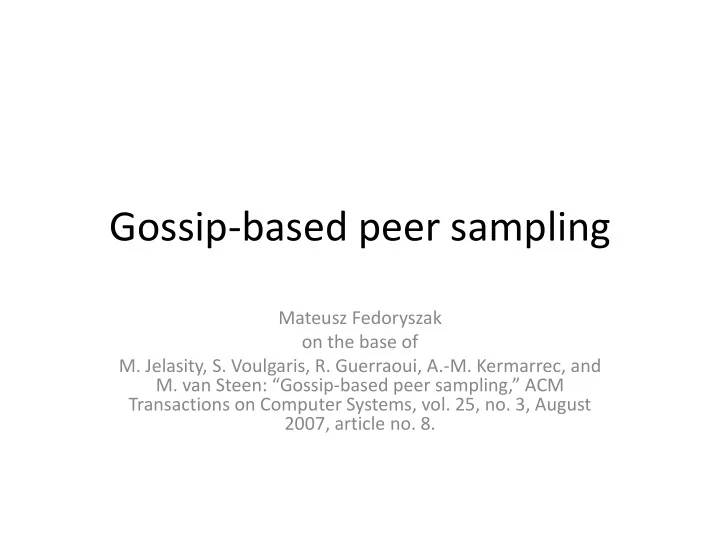

Gossip-based peer sampling Mateusz Fedoryszak on the base of M. Jelasity, S. Voulgaris, R. Guerraoui, A.-M. Kermarrec, and M. van Steen: “Gossip - based peer sampling,” ACM Transactions on Computer Systems, vol. 25, no. 3, August 2007, article no. 8.
The fount of all gossip • Each node has a part of Node 1 the overal knowledge • Information periodically Node 5 Node 2 exchanged • High scalability and Node 4 Node 3 fault tolerance
Who is my neighbour? • We need a method of sampling from a set of nodes with an uniform distribution. • Implement as a gossip-based protocol itself. • Create a generic protocol, then instantiate and evaluate variations.
The knowledge • Each node has a list of c descriptors. • A descriptor is a pair of peer’s IP address and descriptor’s age. • During information exchange, a node sends its own IP address with age 0 and c/2 – 1 of other descriptors it has, randomly selected, not using H oldest.
The cycle • During each cycle a node initiates just one information exchange. • May receive many exchange requests. • At the end of the cycle, all descriptors’ ages are incremented.
Merging • Add recieved descriptors to your own view • Remove duplicates (leave fresher descriptors) • Remove at most H oldest items • Remove at most S items sent to a peer • A care is taken to make view eventually contain exactly c items.
Parameters • Peer selection – selectPeer() • View selection – S – swapping – H – healing • View propagation – Push – Pull
Is it cool enough? • Randomness • Load balancing • Fault tolerance
Rolling the dice • Treat sampled peers as a number sequence • Test randomness using tests defined in MARSAGLIA, G. 1995. The Marsaglia random number CDROM including the Diehard battery of tests of randomness . Florida State University. • Result: only one failing test
The big picture • Treat the network as a directed graph • Vertices ≡ Nodes • There is an edge ( a , b ) iff a stores the descriptor of b
Convergence • Initial overlay – Growing – Lattice – Random • All scenarios lead to a consistent network except push protocol with growing scenario
Do pull!
Indegree standard deviation
Converged indegree distribution
Won’t it blow up? • Catastrophic failure • Churn – 1% – 30% • Bootstrapping – Central – Random
Cluster partition
Catastrophic failure recovery
1% churn – degree standard deviation
1% churn – dead links
30% churn
Findings • It works well • Use push and pull • Swapper for good load balancing • Healer for fault tolerance
Recommend
More recommend